Lion850
National Hazard
   
Posts: 517
Registered: 7-10-2019
Location: Australia
Member Is Offline
Mood: Great
|
|
Report on making Aluminium Iodide
Had a go at Aluminium Iodide today. I know these elements can be combined direct but I wanted to try it in a solvent.
- 50ml water in a 100ml beaker
- 2 gram fine Al powder
- 5 gram I2 crystals
- Stir with gentle heat
- Initially a dark brown color due to dissolved Iodine
- Color suddenly changed to grey - I assume the Iodine reacted with the Al once the solution reached a certain temperature and the resulting grey
color was the excess Al powder
- Added another 5 gram Iodine. Color changed to dark brown, but became light grey within a minute. Quite nice to see the color change as you look at
it.
- Filtered and obtained a clear filtrated. A few drops of this filtrate with Lead Nitrate gives a gold precipitate.
- Boiled the filtrate down to 10ml. Still clear.
- Transfer to small crucible and attempt to dry on top of a boiling beaker. Very slow process, as the volume reduced the color started to become
yellow.
- No further concentration apparent after a yellow crust formed, transferred to stainless bowl and place on a large boiling beaker.
- Finally ended up with some dry-ish yellow lumps and some white crystals - I assume some of the AlI3 dehydrated.
- Recover all and weight, just over 10 grams.
- Transfer to vial, by this time the while crystals had become yellow again and the whole lot had the consistency of soft clay.
Reading beforehand, I saw that AlI3 is said to be soluble in water (which is why I used water, and because I wanted the hydrated yellow salt) but also
that some IlI3 will react with the water; I did not see any free Iodine or smell anything else but steam during the boiling off and drying so I am not
sure if there was any significant hydrolysis.
  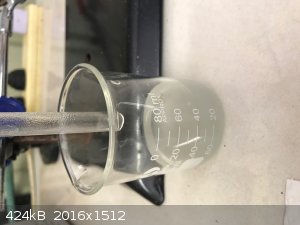 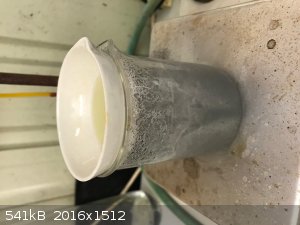   
|
|
|
vibbzlab
Hazard to Others
  
Posts: 241
Registered: 6-11-2019
Member Is Offline
Mood: Always curious
|
|
Good work.
I may try that sometime
Amateur chemist. Doctor by profession
Have a small cute home chemistry lab.

Please do check out my lab in YouTube link below
This is my YouTube channel |
|
|
Lion850
National Hazard
   
Posts: 517
Registered: 7-10-2019
Location: Australia
Member Is Offline
Mood: Great
|
|
@vibbzlab I joined your YouTube channel 
I see that after an hour in the sealed vial the AlI3 in contact with the air in the vial turned a dark color. It must be reacting with the bit of
moisture in the air in the vial.
If you are going to do this, I forgot to say that at one point the water in the beaker heated up for a minute or so, just as the first batch turned
from dark to grey. So, even in 50ml water the reaction releases enough heat to the point where one cannot touch the beaker. Probably best not to use
too little water 
|
|
|
DraconicAcid
International Hazard
    
Posts: 4419
Registered: 1-2-2013
Location: The tiniest college campus ever....
Member Is Offline
Mood: Semi-victorious.
|
|
I doubt the yellow colour is from reaction with moisture (since you made the compound in aqueous solution). It was probably from reaction of hydrated
aluminum iodide with oxygen to give aluminum hydroxide and free iodine (which would then form the triiodide ion, which is dark brown).
Please remember: "Filtrate" is not a verb.
Write up your lab reports the way your instructor wants them, not the way your ex-instructor wants them.
|
|
|
Lion850
National Hazard
   
Posts: 517
Registered: 7-10-2019
Location: Australia
Member Is Offline
Mood: Great
|
|
@DraconicAcid reading online a few different places mentioned the hydrated iodide is yellow. When I was drying it some of the yellow, where the liquid
was thinner at the edges of the small 'pool' became white which I though was because it dehydrated. I scraped off a few white crystals with the
spatula and after a while it formed a pale yellow drop. Seems quite hygroscopic. But what you say above being dark brown makes sense as this seems to
happen in the vial. Seems this change to dark brown happens only at room temperature as it did not happen during the (very) long drying in the open
containers.
|
|
|
Boffis
International Hazard
    
Posts: 1903
Registered: 1-5-2011
Member Is Offline
Mood: No Mood
|
|
Any idea what the hydration state of aluminium iodide is? You certainly haven't made anhydrous AlI3 as it react vigorously with water.
|
|
|
Lion850
National Hazard
   
Posts: 517
Registered: 7-10-2019
Location: Australia
Member Is Offline
Mood: Great
|
|
@Boffis the plan - or rather hope - was to make the hydrated Al (iii) iodide which is said to be yellow. The reaction took place in water, all 10g of
iodine was consumed with no iodine vapour off-gassing when the filtrate was boiled down. The yellow sticky blobs were obtained but as mentioned above
there was also more white/colorless crystals that became yellow and wet in air. The test with lead nitrate confirms the presence of iodine capable of
precipitating lead iodide but exactly which iodide salt of aluminium it is I don’t know. And as mentioned above some of this salt, basically the top
crust, later turned dark yellow in the vial. I’d like to hear opinions as to what it could be.
|
|
|
DraconicAcid
International Hazard
    
Posts: 4419
Registered: 1-2-2013
Location: The tiniest college campus ever....
Member Is Offline
Mood: Semi-victorious.
|
|
Hydrated aluminum iodide is probably said to be yellow because it's almost always contaminated with iodine. The pure stuff should be colourless, as
both the aluminum ion and iodide ion are colourless, and (unlike in lead(II) iodide), you're not going to get charge-transfer absorptions with
aluminum. The white/colourless crystals you made were hydrated aluminim iodide; these bacame yellow and dark yellow on exposure to air as it reacts
with oxygen to give triiodide ion and basic aluminum salts.
You don't have to specify aluminum(III) iodide- aluminum forms no other ions.
Please remember: "Filtrate" is not a verb.
Write up your lab reports the way your instructor wants them, not the way your ex-instructor wants them.
|
|
|
Tsjerk
International Hazard
    
Posts: 3037
Registered: 20-4-2005
Location: Netherlands
Member Is Offline
Mood: Mood
|
|
Apperantly Al(I)I does exist, although not stable by itself, it can be stabilized as adduct with triethylamine.
https://en.m.wikipedia.org/wiki/Aluminium_iodide
|
|
|
Lion850
National Hazard
   
Posts: 517
Registered: 7-10-2019
Location: Australia
Member Is Offline
Mood: Great
|
|
Update on 2 Jan 20:
The yellow product I got a month ago (refer to the first post) slowly turned black/dark brown. It still dissolves very quickly in water (but also make
the water a bit purple) and still gives strong yellow ppt with lead nitrate. When I originally made this I stored it as a wet paste as I did not have
a desiccator and I decided to try again and see if I can get it dryer. Report:
- 50ml water in 250ml beaker.
- 2.3g aluminium powder (very fine)
- 2.5g iodine, stir and heat
- 00:10: Add 50ml water, add 2.5g I2, bring to near boiling,
- 00:11: Observe I2 offgassing for some 10 seconds, switch off heat.
- 00:17: Solution dark born and now exothermic, beaker close to boiling.
- 00:19: Solution turned grey. Add 2g I2. (total 7g). Solution dark again.
- 00:21: Solution turned grey. Add 2g I2 (total 9g). Solution dark again.
- Ad this point the iodine was consumed almost as fast as it was added. Each time 2g of I2 was added the color became dark and turned to grey after
less than a minute.
- 00:35: Total of 28g I2 added at this point. The beaker was now cooler and it started to take longer to consume the iodine.
- 00:38: Add 1.6g I2. Total 29.6g. Color very dark brown.
- 00:42: Color stays dark. Added a very small amount of Al powder to consume the excess I2. Less than 0.5g - but this excess Al powder later caused a
problem....
- 00:45: Solution color changed to grey. Switch on heat to boil down.
- Boil down to 60ml and filter while very hot.
- Only 45ml of filtrate - the rest refuse to go through the filter paper, which seemed to be blocked by the very fine Al excess powder. Maybe I should
have left the iodine in excess and just boiled it out.
- Filtrate is clear when hot but becomes slightly yellow when cooling.
- Placed in desiccator with bed of dry NaOH and small vacuum pumps (miniature pump!!) running continually.
- After 24 hrs the was next to no reduction in volume but the solution became more yellow.
- Transfer to crucible in sand bath. Solution started to boil at 140C.
- After an hour boiling activity stopped and not long after some small amount of iodine vapor was released. Removed from sand bath and iodine
offgassing immediately stopped.
- Placed in desiccator while still hot on bed of NaOH and pull vacuum. After a minute or so, I suspect once the dropping pressure reached a certain
point, the inside of the desiccator turned yellow. This lasted for a few minutes before it cleared up. This must have been the AlI3 sublimating
because still being near its decomposing temperature and reduced pressure?
- Left in the desiccator for 24 hours. Removed, and found it to be a dry crust that crumbles easily. But still extremely hygroscopic.
- Break up and transfer to vial, 32g.
- Dissolved the bits left in the crucible in water and test with lead nitrate, immediate golden yellow ppt.
I await to see if this product also turns dark or whether it lasts better being that it was stored much more dry.
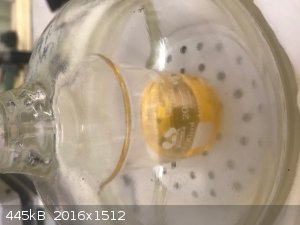 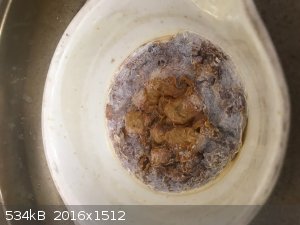  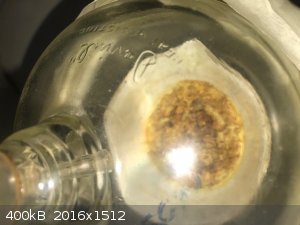 
|
|
|
DraconicAcid
International Hazard
    
Posts: 4419
Registered: 1-2-2013
Location: The tiniest college campus ever....
Member Is Offline
Mood: Semi-victorious.
|
|
If you made it in water, it's not going to be AlI3. At best, it will be hydrated AlI3; at worst, a hydrated mixture of various versions of Al(OH)xIy,
where x + y = 3.
Please remember: "Filtrate" is not a verb.
Write up your lab reports the way your instructor wants them, not the way your ex-instructor wants them.
|
|
|
Tsjerk
International Hazard
    
Posts: 3037
Registered: 20-4-2005
Location: Netherlands
Member Is Offline
Mood: Mood
|
|
Are you contentiously running the vacuum pump during the drying? If you have a valve this is not necessary, just use a little bit of vacuum grease to
seal the lid and close the valve once you have a vacuum, you can keep the vacuum for weeks. Running your vacuum pump continuously will wear it down
fast.
Desiccators are not very efficient in removing bodies of liquid, it will be very slow, as you noticed, because the surface area of evaporation is
small compared to the surface area when it already a crystalline mass.
I don't know if boiling off iodine from a solution containing iodide works very well, as iodine could get stuck as the triiodide.
|
|
|
Amos
International Hazard
    
Posts: 1406
Registered: 25-3-2014
Location: Yes
Member Is Offline
Mood: No
|
|
This reaction can also be conducted in anhydrous alcohols to yield alkyl iodides, if you're interested in investigating that. I would advise against
using methanol though since the reaction is both low-yielding and potentially very dangerous to be near (methyl iodide is extremely volatile as it's
being generated)
|
|
|
Lion850
National Hazard
   
Posts: 517
Registered: 7-10-2019
Location: Australia
Member Is Offline
Mood: Great
|
|
DraconicAcid - I can only say the following about the product:
- when it was concentrated in the sand bath the boiling temp was 140C. Although the level in the crucible was so low that the bulb of the thermometer
was only halfway submerged so maybe the temp was higher. At this temp no iodine was being seen to escape, however not long after the bubbling stopped
iodine vapors was starting to be released. According to WP the hexahydrate decomposes at 185C.
- it is very hygroscopic and dissolved very quick in water
- the solution in water gives lead iodide ppt if mixed with lead nitrate.
Tsjerk - I was running it continually as when I left it off overnight the first time the vacuum seemed to have disappeared. But I since removed excess
grease and cleaned the sealing surfaces and it now seems better at holding the vacuum.
Amos - Thanks for the warning re using methanol. I was thinking about different solvents but am indeed wary of unexpected reactions, and my complete
lack of knowledge of organic chemistry does not help in this regard.
|
|
|